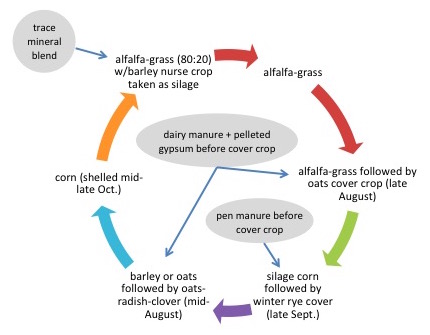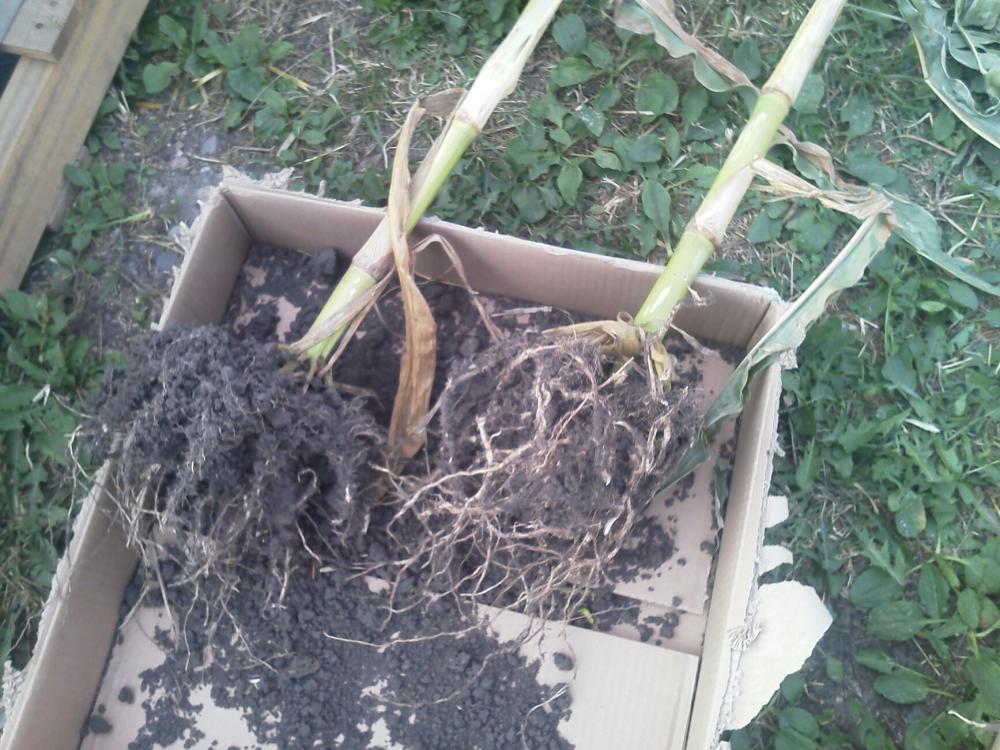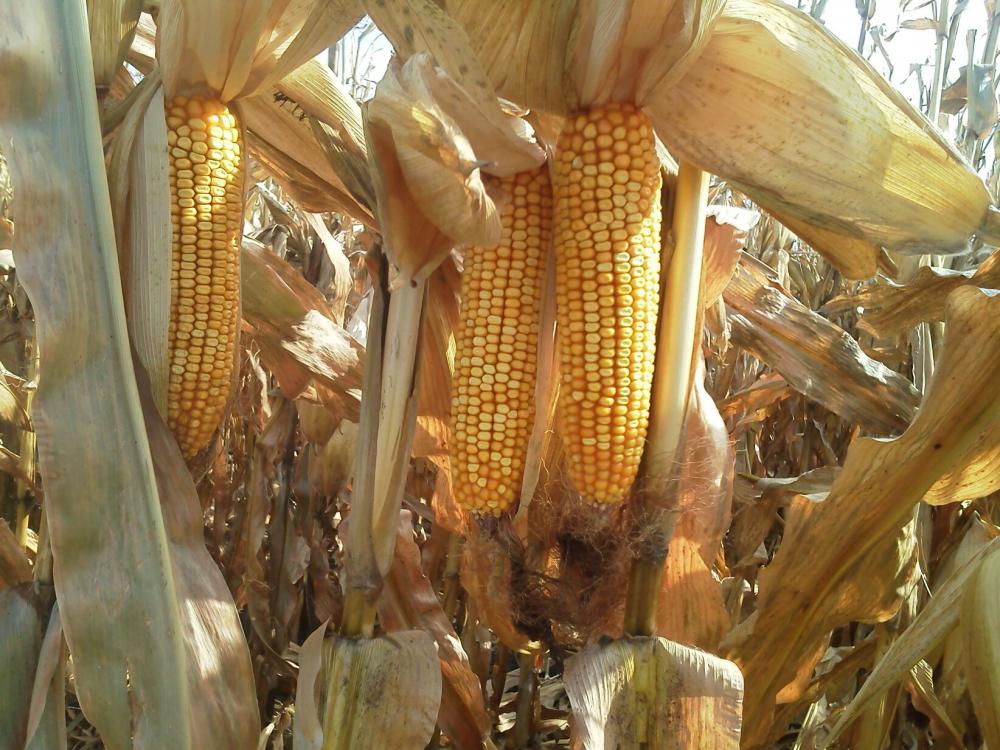eOrganic authors:
Emily Marriott, University of Illinois
Michelle Wander, University of Illinois
Source:
Joe Borgerding, Borgerding Dairy Farm
Introduction
After farming conventionally for over 20 years and dealing with some significant productivity, weed, and pest issues, Minnesota dairy farmer Joe Borgerding began to investigate biological farming and hasn't looked back since. Using mineral balancing, soil ripping, and cover crops, among other practices, Joe has improved his water infiltration and retention, soil quality, and crop productivity. His grass and wild proso millet weed problems and corn borer pests are also greatly reduced. Joe gives as much consideration to his livestock underground (soil biological organisms) as he does to his dairy herd. Describing his farm as organic by design, Joe continuously evaluates and adjusts his farming practices, striving to design a system where everything works together.
Figure 1. Field corn on the Borgerding Dairy Farm. Photo credit: Joe Borgerding, Borgerding Dairy Farm.
Farm History and Overview
Joe Borgerding began farming in 1974 when he took over management of his father's 50-head dairy herd. By 1978, he had purchased the farm's 360 acres and shortly thereafter increased the acreage to 400 with the purchase of some neighboring land. Most of his farming experience was acquired on this home farm, which Joe described as having had tight, anaerobic soils.
When Joe started farming, he used conventional methods. Over time, the farm experienced some significant productivity, weed, and pest issues. Regular soil testing did not reflect the problems he was having. According to Joe, he had “really pretty numbers, but ugly ground” due to chemical carryover, poor mineral balance, and poor soil structure. In 1996, Joe began to investigate other ways of farming. He worked with an agronomist who shared some new ideas, and also read material by William Albrecht and others. He began to focus on the biology of his soils, and worked to balance his soils by adding soluble calcium and sulfur in the form of fly ash and gypsum. He also started to transition the farm to organic production in 2000 and became certified organic in 2004. Compared to when he was farming conventionally, Joe finds that organic farming requires 50% more labor and twice as much management. Describing his farm as organic by design, Joe continuously evaluates and adjusts his farming practices, striving to design a system where everything works together.
The Borgerding Dairy Farm is located in central Minnesota in the warm summer, humid continental climate zone. Summers are warm and humid and winters are cold with heavy snowfall. The area receives about 28 inches of rain and 47 inches of snow per year. The farm includes a mix of soil types. The home farm has heavy clay loams (classified as Normania or Flom) and the additional owned and rented land is composed of dryland sand, irrigated sand, and peat ground.
Currently Joe, his wife Toni, and their two sons farm around 1080 acres—about 680 acres are owned and an additional 400 are rented. The family operates the farm together; Joe's sons manage the cows, allowing Joe to focus on crop production. The farm also employs Joe's daughter half-time, his nephew full-time and an additional full-time employee.
While primarily focused on dairy, they also raise some beef. The herd size is currently about 365 head, composed of 175 milk cows, 10 dry cows, 60 bred heifers, 80 younger heifers, and 40 beef. The cattle are supported by 220 acres of permanent pasture and an additional 70 acres of rotational alfalfa-grass meadows for hay and some grazing. The remaining acres are used to produce corn, soybeans, alfalfa, and small grains like oats and barley. Alfalfa is grown on 160 to 200 acres every year.
Milk and beef are sold to Organic Valley. Surplus hay is sold to area farmers. The majority of corn and grain is fed to cows and steers, and extra is sold to organic farmers and brokers. About 20% of the soybeans are roasted and fed on-farm as a protein supplement and the rest is sold.
Infrastructure and Technology
Joe invests in high-quality equipment and partially offsets the cost by performing around 500 acres of custom work (planting, chopping, tilling, and baling) for neighbors each year. This also gives other local farmers access to good equipment. Additionally, Joe has invested in a lot of tile drainage over the years.
Joe has made a significant investment in technology with the purchase of GPS, auto-steer, and yield monitoring. With the help of an agronomic consultant, Joe uses this technology to assist with on-farm research, experimentation, and recordkeeping. He is able to accurately track the locations of different practices and compare yields.
They now have radio collars on cows that monitor activity and rumination to detect when cows are in heat. The information is sent to the office so farmers know when cows are ready for breeding. With this technology, Joe no longer needs to feed and house a bull. This increases safety and widens their selection of bulls for breeding.
Key Practices
Crop Rotations
Joe's crop rotations are complex and variable. Rotations and crops are selected based on soil type, irrigation, and proximity to the dairy operation. For example, silage corn is only grown on ground close to silage storage (Fig. 2); crops that require significant nitrogen (N) fertility are grown close to the manure lagoon; and more clover and alfalfa are grown on sandy soil. A major focus is on covering the ground early in the season. To that end, Joe is increasing his use of winter annuals like winter oats. Instead of having bare ground in April and May, winter annuals are growing as soon as the snow melts. This way he makes the most of early season sunlight while protecting soils year-round and reducing soil water loss.

Figure 2. An example of a feed crop rotation. This type of rotation would typically be used on heavier soils, close to the home farm. Trace minerals are applied before alfalfa to improve feed quality. The barley silage nurse crop provides a lot of tonnage, doesn't lodge, and allows them to get a second cutting of alfalfa.
Soil Fertility and Testing
Joe began pursuing alternative farming practices in the late 1990s to address productivity problems caused by salt and chemical carryover. These heavy clay loams were alkaline (pH up to 8) with high magnesium (Mg) base saturation (up to 35%). At that time, soils had poor aeration, infiltration, and root penetration and there were few earthworms. Joe applied fly ash to supply soluble Ca and S. He also conducted mechanical ripping of his cropland to break up the salt and chemical layer. Mineral balancing and a focus on soil biology, along with the recent addition of cover crops, have greatly improved his soil quality and productivity (Fig. 3).
Since the farm generates ample manure from the dairy operation, Joe prefers to fertilize with manure. Liquid manure has the highest amount of available N and is typically used on corn. Silage corn typically receives around 5,000 gallons liquid manure per acre, while shelled corn receives 6,000 gallons per acre. Pen manure that includes a lot of straw bedding is used on small grains like oats and barley. There is not enough manure produced on-farm to meet all of the fertility needs, so Joe annually applies up to 200 tons of poultry litter and potassium sulfate (K2SO4) on cropland located farther away from the home farm (up to 5 miles away). Some manure is partially composted on-farm and applied to pastures. Joe works with an agronomist to decide N fertilization rates, taking into account N from cover crops, alfalfa, and past manure use. He also uses nitrate testing of corn stalks in the fall to see if N was over- or under-applied to fine-tune their fertilization system. Joe finds that working with the agronomist is a helpful way to make sure nothing is missed.

Figure 3. With improvements in soil structure, corn root growth has improved. Photo credit: Joe Borgerding.
Gypsum is applied regularly to provide soluble calcium and sulfur on both cropland and pasture. To further balance minerals, Joe also pays attention to iron (Fe) and manganese (Mn) levels, aiming to have soil test values near 20 ppm for each. Over time, he has seen Fe levels decrease and Mn levels increase, as desired. A trace mineral blend is usually applied before alfalfa to improve feed quality. When farm finances can support it, Joe fertilizes pastures with a trace mineral blend that also includes humates.
Joe tests his soils every 3 to 4 years on both cropland and pastures. He uses soil tests as monitoring tools, but does not use them specifically to determine fertilizer amounts. His priority is to promote soil health and biological activity to mobilize the nutrients already present in his soil. He believes cover crop root systems and soil fungi are particularly important in increasing nutrient availability. Additionally, Joe uses feed tests to inform his soil management, believing they are a better way to evaluate the nutrient availability in his soils than soil tests alone.
Table 1. Soil test results (0-6") from 1996 and 2014 for selected fields and recent soil test results for selected pastures on the home farm.

Soil test results in Table 1 show the impact of Joe's mineral balancing efforts, in that Mg base saturation has decreased and Ca base saturation has increased in cropped fields. Iron and Mn levels have declined over time in cropland.
Joe is interested in new soil tests that provide information on soil biology. He does occasional humus and Solvita testing on existing fields and tests all new ground. Interpretations are still being developed for these tests and, while at this point Joe doesn't use them to make management decisions, he does want to have benchmarks for future use of these tests as interpretations improve.
Use of Cover Crops
In 2013, Joe started using cover crops in his annual forage crops. Now, cover crops are used extensively to improve soil quality and moisture retention. Joe believes that the improvements he has made in soil quality over the last 15 years could have been accomplished in 5 years if he had started using cover crops with the calcium and sulfur amendments.
Joe recently made a significant change in his cover crop practices. Formerly small grains like oats and barley were underseeded with a clover cover crop. After the grain was harvested, the clover would continue to grow and fix N. After growing for an additional 6 weeks, the clover was incorporated with manure. Now, Joe harvests the small grain, applies manure, and then seeds a cover crop mix. This new practice provides multiple benefits. It allows him to fine-tune his cover crop mix, depending on his goals for particular fields. He can incorporate the manure earlier, giving it more time to break down before winter, while also having a cover crop in place to take up mineralized nutrients. Additionally, he can seed the small grain heavier without needing to provide sunlight for the underseeded clover crop and if the small grain lodges, it doesn't smother the cover crop. Finally, using a winter cover gives Joe more time in spring, since some land is already planted. It is particularly helpful on river bottomland that tends to be wet and cold in spring. Joe also believes that soil with a cover crop has less frost and thaws more quickly in the spring, resulting in better infiltration of early spring rains. He is experimenting with strip tilling, expecting it to allow him to create a black berm for planting while leaving some of the cover crop intact.
Pest Management
Grass weeds have been virtually eliminated on the farm. Wild proso millet used to be a significant problem throughout the farm, but now occurs rarely. Joe attributes this to improvements in soil quality. Broadleaf weeds, such as pigweed and ragweed can still be problems, but are not hard to manage. Flaming is used to control some broadleaf weeds in corn. Use of auto steer and new weed control discs allows Joe to set the cultivator much closer to the crop rows, minimizing the need for harrowing. Cover crops are also part of Joe's weed control strategy.
Currently there are few major pest problems in the field crops. Corn borer used to be a significant pest when Joe was farming conventionally, but now is not a problem. According to Joe, they used to see more pests, but now they see more beneficial insects including lady bugs, lacewings, parasitic wasps, and dung beetles.
Grazing Practices
The herd is composed of 4 groups: dairy cows, dry cows, bred heifers, and beef cows. Each group is kept on a separate farm. Dairy cows are managed most intensively and get new pasture every day. The other groups are moved every 3 days or so. Dairy cows graze during the day, receiving at least 30% of their dry matter intake from pasture, and are housed in a freestall barn during the night. They receive grain, minerals, and corn silage as a total mixed ration in the barn in the mornings. Corn silage is an important source of starch to balance the high protein content of young grass and keep milk urea nitrogen levels down. The rolling herd average is 16,700 lb milk/cow/year with no purchased protein. The other cattle are primarily forage-based with some grain fed to young stock (3–5 lb/day). All feed, hay, and bedding is grown on the farm, and minerals are purchased.
Pastures are planted with cool-season perennials and are divided into 2–4 acre paddocks. During the summer, when pasture productivity is high, paddocks are divided in half with a break wire, but when pasture growth slows, cattle are given access to the entire paddock at once. Alfalfa is rotated throughout the farm's cropland, providing additional grazing during the summer slump when grass production slows. An additional 30–40 acres of alfalfa are usually strip grazed (2–3 acres at a time) each year after the second cutting of hay. In years with sufficient rain to keep pastures productive during the late summer, they may not need to graze these acres of alfalfa, but they provide additional flexibility.
Water is provided in the barn as well as in stock tanks near each paddock which are moved with the herds. Black plastic pipe is used to run water to the pasture with taps every 300–400 feet.
Pasture Renovation
Pastures are renovated when the species composition needs to be adjusted (e.g. too much bluegrass, thistles, or weeds) or when productivity seems to drop. To renovate, a pasture is tilled, pen or liquid manure is applied, and the field is seeded with warm season grasses—usually a sudangrass-ryegrass mix. Without the use of a summer annual, the old pasture mix would immediately regrow. The sudangrass-ryegrass mix also provides additional high-quality grazing in the late summer. In the fall, the pasture is reseeded with their pasture blend of clovers, grasses, ryegrass, and fescue. Approximately 10 acres of pasture are renovated each year. Weed and productivity issues may also be addressed through adjusting grazing practices (see the eOrganic webinar "Learning from Our Observations of Pastures & Livestock: Preventing Pasture Problems on the Organic Dairy Webinar by eOrganic").
Case Study Takeaway Points
- Joe attributes improvements in soil quality to mechanical ripping, mineral balancing using calcium and sulfur amendments, and cover crops.
- An emphasis on supporting the soil biological community guides farming system design and the use of year-round cover.
- Investment in technology is expected to increase the effectiveness of on-farm experimentation.
References and Citations
- Flack, S. 2014. Learning from our observations of pastures & livestock: Preventing pasture problems on the organic dairy [Online]. eOrganic Webinar. eXtension Foundation, eOrganic Community of Practice. Available at: http://articles.extension.org/pages/71819/learning-from-our-observations-of-pastures-livestock:-preventing-pasture-problems-on-the-organic-dai (verified 16 March 2017).
- Hutjens, M. and L. E. Chase. 2012. Interpreting milk urea nitrogen (MUN) values [Online]. eXtension Foundation. Available at: http://articles.extension.org/pages/11322/interpreting-milk-urea-nitrogen-mun-values (verified 10 March 2016).
Additional Resources
- Gamroth, M. 2010. Developing a grazing system for your organic farm [Online]. eXtension Foundation, eOrganic Community of Practice. Available at: http://articles.extension.org/pages/18345/developing-a-grazing-system-for-your-organic-farm (verified 17 March 2017).
- Gamroth, M. 2014. Establishing and maintaining productive pasture on organic dairy farms [Online]. eXtension Foundation, eOrganic Community of Practice. Available at: http://articles.extension.org/pages/18344/establishing-and-maintaining-productive-pasture-on-organic-dairy-farms (verified 17 March 2017).
- Harper, W. S., K. Hills, and F. Magdoff. 2012. Soil management for better fertility on organic livestock farms [Online]. extension Foundation, eOrganic Community of Practice. Available at: http://articles.extension.org/pages/18323/soil-management-for-better-fertility-on-organic-livestock-farms (verified 17 March 2017).




